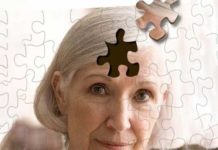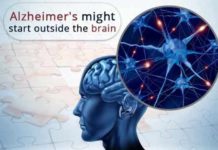
Overview and Statistical Facts
Brain is an amazing organ, which helps a person to think, remember, plan, organize, make decisions and so on that help in leading a normal life. With age, the mental abilities of a person decrease. Older adults might find it difficult to recall words, names, perform multiple tasks at a time or pay attention.
Incidentally, in some people, this degeneration of brain tissue is more severe, causing irreversible brain damage, which leads to the development of Alzheimer’s disease (AD). It is the most common form of dementia affecting older population. Dementia is a general term used to define decrease in mental ability – severe enough to interfere with everyday life. Dementia is not a specific disease, but has a wide range of associated symptoms, such as memory loss and decline in thinking abilities.
Alzheimer’s develops slowly and affects the part of brain, which controls thought, language and memory. People with Alzheimer’s initially experience memory loss and confusion that is generally attributed to normal brain aging. However, with time, patients with AD start displaying changes in behavior and personality, decline in cognitive abilities like making decisions and language skills, and trouble in identifying family and friends.
In severe cases, AD causes severe loss of mental function. These changes occur due to worsening of connections between neurons of brain, eventually leading to the death of neurons. It generally affects people of age 65 years and above.
Alzheimer’s has emerged as the 6th leading cause of death in the U.S. Still, only 1 in 4 people with AD gets diagnosed. At every 66 seconds, a person in the US develops Alzheimer’s. Approximately 44 million people are living with AD or any other form of dementia globally.
AD is most prevalent in West European countries, closely followed by North American nations. It is least common in Sub-Sahara African countries. The global cost incurred for managing AD and dementia amounts to nearly 605 billion USD, which is approximately 1% of the global gross domestic product (GDP).
It is more common in women than men. Out of every three AD patients, two are women. Nearly 30% of AD patients also have heart disease and 29% of them suffer from diabetes. With the increase in global life expectancy, the prevalence of AD in elderly population has substantially increased.
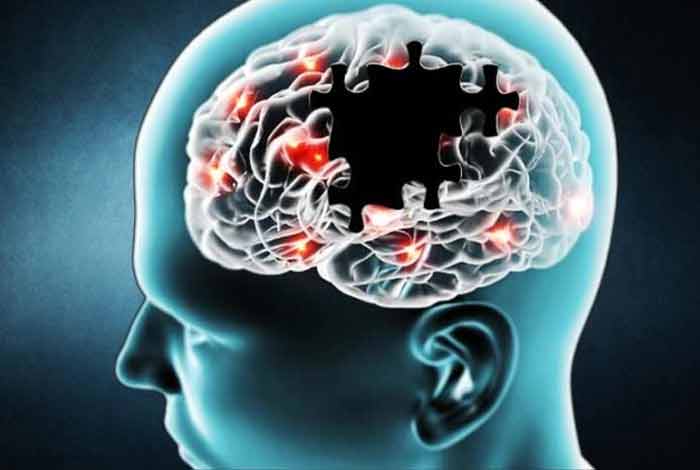
Types and Symptoms of Alzheimer’s Disease
Types of Alzheimer’s Disease:
Although every patient of Alzheimer’s would develop the same symptoms eventually, still, it can be broadly divided into two types:
Early-Onset Alzheimer’s Disease
It is described in people, who are below the age of 65 years, generally in their 40s and 50s at the time of diagnosis. It is a rare form of disease and found only in 5% of people suffering from AD. People with Down Syndrome are at a higher risk of developing this form of AD.
There are a few ways that differentiate early-onset Alzheimer’s from other types of the disease. Patients with this type of AD display more brain changes linked to Alzheimer’s. It is also thought to have some connection with the person’s genetic material – chromosome 14.
Late-Onset Alzheimer’s Disease
It is the most common form of Alzheimer’s disease, which affects people, aged 65 years and above. It might or might not run in families. Scientists have not been successful in linking any particular gene that might be responsible for development of this type of disease. However, till date, there is no scientifically-backed explanation as to why some people develop Alzheimer’s and some do not.
Familial Alzheimer’s Disease (FAD)
It is a rare form of Alzheimer’s that has been proved to be caused due to genetic factors. In the affected families, members of at least two generations must have a history of Alzheimer’s. It is found in less than 1% of the Alzheimer’s patients; mostly in those, who have early-onset Alzheimer’s.
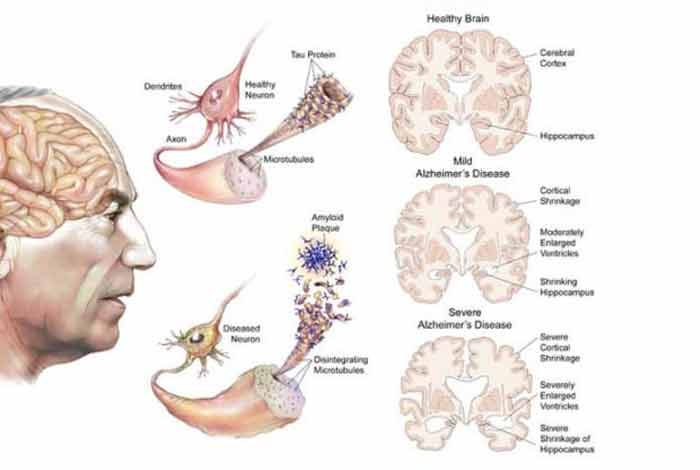
Symptoms of Alzheimer’s Disease:
In the initial phases, the disease might only present itself with increased incidents of forgetfulness and mild confusion. With time, the symptoms become worse. The rate at which the disease progresses varies from person to person.
The patient might be the first one to notice changes in his ability to remember things or organizing his thoughts. It is also possible that the person remains unaware of his disease and the symptoms get noticed only by his/her family, friends and co-workers.
Brain changes related to Alzheimer’s cause increased trouble with:
1) Memory
People suffering from Alzheimer’s might:
- Repeat sentences and questions again and again, without realizing that they have asked the question before
- Forget conversations, appointments and events
- Routinely misplace objects or place them at unexpected locations
- Lose their way in familiar places
- Forget names of family members and everyday objects
- Experience trouble in recalling right words for identifying objects, expressing their thoughts or for conversing
2) Thinking and Reasoning
A patient of Alzheimer’s finds it difficult to concentrate and think, especially regarding things that involve abstract concepts like numbers. Patients cannot multi-task and are unable to manage their finances. These difficulties arise due to inability of the person to process numbers.
3) Making Judgments and Decisions
People with Alzheimer’s find it difficult to effectively deal with everyday problems, such as unexpected driving situations or food burning on the stove.
4) Planning and Performing Familiar Tasks
As the disease progresses, patients find it difficult to perform routine activities like playing their favorite games or cooking meals. In advanced cases, patients forget how to perform basic tasks like bathing and dressing.
5) Changes in Personality and Behavior
Alzheimer’s patients might experience following changes in their behaviors:
- Depression
- Distrust in others
- Apathy
- Change in sleeping habits
- Irritability and aggressiveness
- Loss of inhibitions
- Social withdrawal
- Delusions
- Wandering
- Mood swings
Numerous skills like the ability to read, sing and dance, engage in crafts and hobbies, enjoy old music, tell stories and reminisce are not lost until the disease progresses to an extremely advanced stage. This happens because habits, skills and information learned in the early phases of life are among the last to be lost as the disease progresses. The region of brain responsible for storing the information gets affected in the end. By capitalizing on these abilities, patients can be helped to maintain quality of life even when they progress to moderate phase of disease.
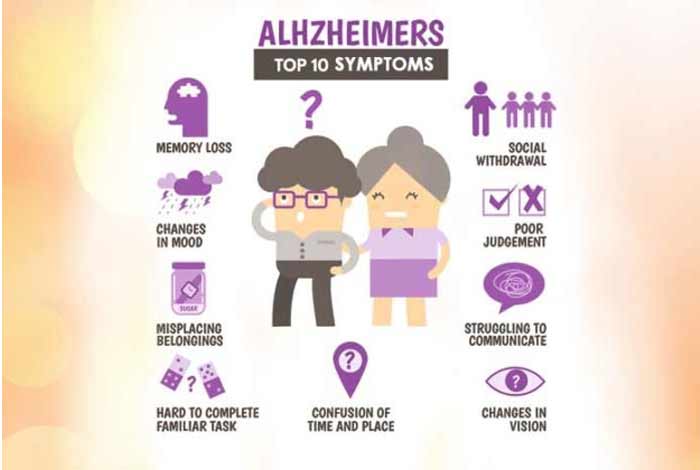
Alzheimer’s is a disease that becomes worse with time. The rate at which the disease progresses varies from person to person. On an average, a person lives for four to eight years after being diagnosed with Alzheimer’s, but there are known cases, wherein a person lived for two decades after AD diagnosis, depending on other factors.
Alzheimer’s can be broadly divided into three phases: Mild, moderate and severe. However, it should be noted that sometimes it might become difficult to assign a patient to a particular phase as the symptoms might overlap sometimes.
Brain changes leading to Alzheimer’s begin years before the symptoms surface. There is a common trajectory, which is followed by the disease from beginning to its merciful end. The exact number of stages in this disease is somewhat arbitrary. Some experts use a three-phase model, whereas others divide the progression of disease into seven stages for a more extensive understanding of disease progression. These are:
1) No Impairment
During this stage, there is no evident proof of AD. There are also no symptoms of change in memory or other symptoms of dementia. This duration, which can last for a number of years, is called “pre-clinical Alzheimer’s disease.”
2) Very Mild Decline
The patient might feel slight changes in his memory, although not to a point that it can be distinguished from normal age-related changes in memory. The person still manages to do well on memory tests, and there is a high chance that the disease might go undetected by physicians and family members.
3) Mild Decline
In this stage, the patient might feel that he/she is facing some problems with his memory like forgetting familiar places, words or location of everyday objects. Some of the common difficulties faced by the person might include:
- Difficulty in coming up with right name or word
- Trouble remembering names when introduced to new people
- Difficulty in performing tasks in social or work settings
- Losing or misplacing objects
- Increase in trouble to plan or organize
- The person might show impaired cognitive function on memory and cognitive tests.
4) Moderate Decline
It is the longest stage of the disease and can last for many years. With the progression of disease, the patient requires greater care. Some of the symptoms presented by the person at this stage include:
- Forgetting about events or one’s own personal history
- Feeling moody and withdrawn
- Being unable to recall one’s own address or telephone number
- Increased risk of wandering or getting lost
- Trouble controlling bladder and bowels
- Personality and behavioral changes, including delusions or compulsive, repetitive behavior like hand-wringing or tissue shredding
5) Moderately Severe Decline
This stage lasts for about 1 and ½ years and requires extensive care and support from family and friends. Patients, who do not receive proper care, often develop feelings of anger and suspicion. Patients become completely dependent on their care givers and cannot function independently. Some of the symptoms include:
- Increased confusion
- Difficulty in solving easy arithmetic problems
- Difficulty in choosing proper clothing according to the season or occasion
- Remember significant details about themselves and their family
- Can still eat and use the toilet by themselves
6) Severe Decline
Patients in this phase require constant supervision and professional care. Some of the symptoms observed in this stage are:
- Increased confusion or unawareness of environment and surroundings
- Major changes in personality
- Behavioral problems
- Difficulty in identifying faces, except those of closest friends and relatives
- Loss of bladder and bowel control
- Inability to recall most of personal history
- Wandering
7) Very Severe Decline
In this stage, the individual loses his ability to respond to different stimuli from the environment, carry out conversation and eventually control their movements. They might be able to say some words or phrases, but communicating about pain becomes difficult for them. With further progression of disease, significant changes occur in the personality of the patient, and he/she becomes increasingly dependent on his caregivers for carrying out day-to-day activities.
At this stage, individuals might:
- Require round-the-clock assistance with daily activities and personal care
- Lose awareness of their surroundings and recent events
- Find difficulty in walking, sitting and swallowing
- Face more difficulty in communicating
- Become more vulnerable to infections, especially pneumonia
Risk Factors of Alzheimer’s Disease
Factors that increase a person’s risk of developing the disease are:
Age
The biggest risk factor for developing Alzheimer’s is increasing age. Normal aging does not lead to Alzheimer’s, but the risk increases tremendously as a person reaches 65. People having rare genetic changes are predisposed to Alzheimer’s as early as 30 years.
Family History and Genetics
Alzheimer’s is known to run in families. If a first degree relative like parent or sibling develops Alzheimer’s, the chances of a person to develop the disease increases significantly.
Most genetic reasons leading to the development of Alzheimer’s are still unexplained. The strongest genetic risk factor that has been found till date is apolipoprotein e4(APoE4). However, not every person with this gene develops Alzheimer’s.
Down Syndrome
People having Down syndrome are more likely to develop Alzheimer’s disease. The symptoms also appear 10-15 years earlier in these people as compared to the general population. A gene present in the extra chromosome, found in people with Down syndrome, increases the risk of developing AD.
Gender
It has been found that women are at a higher risk of developing Alzheimer’s than men. This is partly attributed to the fact that women have a slightly higher life expectancy than men. The role of estrogen in Alzheimer’s disease is also being researched. It has been suggested that post-menopausal women should not be prescribed with estrogen to decrease the risk of developing Alzheimer’s.
Mild Cognitive Impairment
Mild cognitive impairment (MCI), also known as Incipient Dementia or Isolated Memory Impairment, is a syndrome which affects the brain of a person. In this condition, a person’s cognitive abilities are impaired more than normal, considering his age and education. However, the impairment is not severe enough to hamper his day-to-day activities.
People having MCI are at an increased risk of developing Alzheimer’s later in their lives. By adopting a healthier lifestyle and compensating for memory loss at this stage might help in delaying or preventing Alzheimer’s.
Past Head Trauma
People who have had head trauma at some point of time in their lives are at a higher risk of developing Alzheimer’s.
Lifestyle and Heart Health
There are no lifestyle changes that help prevent Alzheimer’s. However, there are some evidences that point towards a relationship between risk of heart disease and developing Alzheimer’s. The risk factors associated with heart disease are:
- Lack of physical exercise
- Obesity
- Smoking, active or passive
- High blood pressure
- High blood cholesterol levels
- Poorly controlled type II diabetes
- A diet lacking in fresh fruits and vegetables
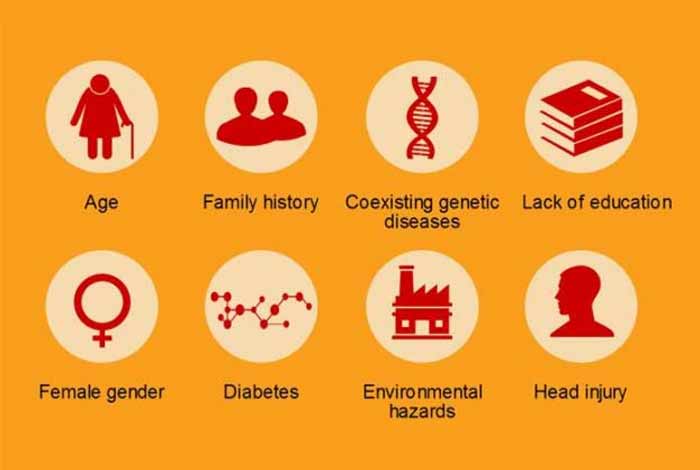
Do I have Alzheimer’s Disease?
It should be kept in mind that Alzheimer’s is not a part of normal aging. According to National Institute on Aging, if you observe any of the below mentioned symptoms, you must consult your doctor.
- Memory loss that is disrupting your daily life, such as getting lost in familiar places or asking same questions repeatedly
- Trouble handling money and other financial transactions
- Difficulty completing familiar tasks at home, work or at leisure
- Decreased or poor judgment
- Misplacing things or being unable to retrace steps to find them
- Changes in mood, personality or behavior
If you observe any of the afore-mentioned symptoms, it is not necessary that you have Alzheimer’s. It is important that you consult your doctor and seek proper medical advice. You might have depression or reaction to some drug interactions. Accurate diagnosis by an expert can help you in managing your symptoms more effectively.

Causes and Prevention of Alzheimer’s Disease
Causes of Alzheimer’s Disease:
The exact cause of Alzheimer’s has not been understood completely. It is thought to occur due to a combination of factors, including genetic, environmental and lifestyle that affect the brain over a long period of time. In less than 5% of Ad patients, Alzheimer’s is caused by specific genetic factors. While the cause of Alzheimer’s is yet to be understood, its effect on the brain has been completely understood.
Alzheimer’s is caused by the degeneration of brain, which interferes with the transmission of signals between brain cells. When the brain cells are unable to communicate effectively among themselves, it leads to problems in thinking, feeling and behavior. Distinct regions in the brain are responsible for carrying out different functions in an organism. One region of brain is responsible for thinking, other for movement and so on. When the cells in a particular region of the brain get damaged, the function of that region gets impaired.
In AD, as more and more cells die, the brain starts to shrink. When the brain tissue are observed under microscope, these abnormalities are observed, which are considered as hallmarks:
Plaques
These are formed due to accumulation of a protein, known as beta-amyloid, which when gets deposited in the brain leads to substantial damage to the brain cells, and destroy them in several ways. It is known to interfere in brain-cell communication. Although the exact cause of death of brain cells is not known, these plaques are the most probable reason for the same.
Tangles
An internal support and transport system, present inside the brain, is responsible for sending nutrients and other necessary materials throughout their long extensions. For proper functioning of this system, a protein, called Tau is required. In people with Alzheimer’s, there occur twists in the tau protein threads, resulting in abnormal tangles. This causes a hindrance in the normal functioning of the transport system, which is thought to be one of the major reasons for the decline and death of brain cells.
Loss of Connections between Neurons Responsible for Memory and Learning
Brain cells die when they lose their connectivity with other brain cells. Once the brain cells die throughout the brain, the affected region begins to atrophy or shrink. When the final stage of Alzheimer’s is reached, widespread death of brain cells has already occurred, causing the brain tissue to substantially shrink.
Research is being carried out to study how aging can damage brain in a way that leads to the development of Alzheimer’s. Some of these age-related changes include atrophy (shrinkage of some parts of the brain), production of unstable molecules, called free radicals, inflammation, and breakdown of energy production within brain cells.
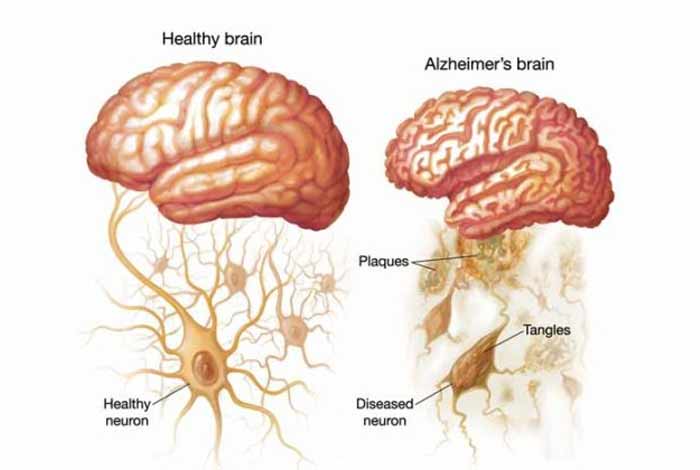
Prevention of Alzheimer’s Disease:
Presently, there is no specific way to prevent Alzheimer’s. Research is underway to develop prevention strategies. The strongest evidence that has been found so far is by reducing the risk of developing cardiovascular disease. Some of the factors that can lead to cardiovascular disease are high cholesterol levels, excess weight, high blood pressure and diabetes.
The risk of developing cardiovascular disease can be decreased by following a Mediterranean diet in which emphasis is laid on consuming fresh produce, healthy oils, and foods low in saturated fat. This diet has also been found to lower the risk of Alzheimer’s. Being physically, mentally and socially active is also known to reduce the susceptibility of developing Alzheimer’s.

Diagnosis and Tests of Alzheimer’s Disease
While there is no specific test to diagnose Alzheimer’s, AD is usually diagnosed after a thorough medical check-up in which the family history of a person is collected along with physical examination, laboratory tests and the characteristic changes in thinking, everyday activities and behavior.
The medical practitioner analyzes, whether a person is having any of the underlying conditions such as depression, vitamin B 12 deficiency and normal pressure hydrocephalus. Early diagnosis of Alzheimer’s is necessary as in some cases, a few common symptoms can be easily treated. In many cases, Alzheimer’s is only confirmed by examining the brain of the patient after death. For medical assessment of the patient, following parameters are evaluated:
Patient History
A complete history of the patient is considered to determine if Alzheimer’s or any other form of dementia runs in his/her family. Also, facts regarding changes in his behavior and personality as well as whether he is on any kind of medication is determined.
Physical Examination
This includes measuring blood pressure and other vital signs of the disease in patients. This helps physicians detect any other condition that might cause or occur with AD.
Neurological Tests
A person’s sensory function, reflexes, eye movements, balance and other cognitive functions are assessed to help identify any condition that might arise due to Alzheimer’s.
Cognitive and Neuropsychological Tests
These tests are designed to examine a person’s memory, attention, counting, language and problem-solving skills that are related to normal functioning of the brain.
Laboratory Tests
Urine and blood tests are carried out to rule out any disease that might be responsible for the symptoms. Also, in people with progressive symptoms of Alzheimer’s, APOE genotyping is done to examine the probability of late-onset Alzheimer’s. However, the clinical usefulness of this test is still under research.
Brain Scans
Brain scans are done to identify tumors, strokes and other problems that might be causing dementia. These are also used to identify any structural and functional changes in the brain. Some of the most commonly used scans are:
Computed tomography (CT): X-rays are used to produce images of the brain that are displayed on a computer.
Magnetic resonance imaging (MRI): Radio waves and magnetic fields are used to produce images of the brain with intricate details about its tissue, nerves, etc.
Positron emission tomography (PET): Radiations are used to produce pictures of brain activity.
Positron emission tomography (PET): These tests are used to determine if depression or any other underlying condition is causing or contributing to the patient’s symptoms.
Genetic Tests
In cases, where Alzheimer’s is caused due to genetic factors, these tests can be performed for screening people, who are at a higher risk of developing the disease. A person should consult his family members, a primary care doctor and genetic counselor before getting the test done.
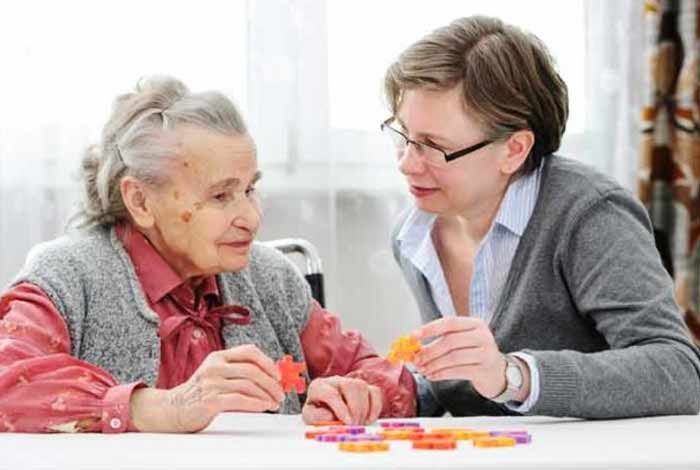
Treatment and Care for Alzheimer’s Disease
Treatment of Alzheimer’s Disease:
There are no medicines available for decreasing the progression of Alzheimer’s. Although the disease can’t be cured completely, a few medicines can be used to manage behavioral symptoms, maintain mental function and slow down the symptoms of the disease. These drugs allow patients to live their lives with dignity, comfort and independence for a longer period of time, and provide relief to their caregivers as well. Most of these medicines work best in the early and middle stages of Alzheimer’s.
Treatment for Mild to Moderate Alzheimer’s:
Cholinesterase inhibitors, a class of medicine, are prescribed for reducing and managing behavioral symptoms of early and mild Alzheimer’s. Galantamine, rivastigmine and donepezil are the drugs belonging to this class. However, how cholinesterase inhibitors work to improve the symptoms of disease is still unclear.
Treatment for Moderate to Severe Alzheimer’s:
Memantine, an N-methyl D-aspartate (NMDA) antagonist is used for managing moderate to severe Alzheimer’s. It helps the patients to lead a near normal life for a little longer time than they would do without medication.
Sometimes, antidepressants are also prescribed to manage behavioral symptoms in Alzheimer’s patients. Moreover, zolpidem, eszopiclone and others similar drugs should be used with caution as they might increase confusion and the risk of falling in these patients. Likewise, anti-anxiety medications, such as clonazepam and lorazepam also increase the risk of confusion, dizziness and falls in AD patients.

Care for People with Alzheimer’s Disease:
As the disease progresses, the patient becomes increasingly dependent on his caregivers for carrying out his/her daily activities. Following measures can be taken by the caregivers to help patients maintain their independence and dignity as they become more and more dependent:
1) Reduce Frustrations
Alzheimer’s patients might become frustrated as daily chores become a burden for them to perform. Some of the steps that can be taken to limit these challenges and ease frustrations include:
Schedule Wisely:
A routine can be established for reducing confusion and making every next day less frustrating. These patients are still able to learn and follow routines.
Take your Time:
Patients with Alzheimer’s take more time to perform any task as compared to healthy individuals. A caregiver is thus advised to have patience.
Involve the Person:
The patient should be involved as much as possible in carrying out easy tasks like laying out the table or getting dressed.
Provide Choices:
It is advised to give at least a few choices to the patient rather than no choice.
Provide Simple Instructions:
Alzheimer’s patients best respond to clear, one-step instructions.
Reduce Distractions:
Distractions should be kept to the minimal to help Alzheimer’s patient focus on the work he is doing.
2) Be Flexible
Caregivers are advised to set their routines in accordance with that of the patient to maximize the quality of interaction and reduce frustration. They are suggested to lower their expectation levels, so as to avoid self-frustration.
3) Create a Safe Environment
People with Alzheimer’s have impaired judgmental and problem-solving skills that increase a person’s susceptibility to injury. Following measures can be taken to ensure patient safety:
Prevent Falls:
Scattered rugs, extension cords and other similar objects that can make the patient trip or fall should be avoided.
Use Locks:
Cabinets containing potentially hazardous objects, such as medicines and guns should be kept locked.
Take Fire-Safety Precautions:
Matches, lighters and other fire-producing objects should be out of reach of the patient.
4) Focus on Individualized Care
Each Alzheimer’s patient has his own set of symptoms, and hence requires tailor-made care giving techniques.

OTC Medications and Self-Management Methods for Alzheimer’s Disease
There are no over-the-counter medications available for managing Alzheimer’s disease. However, vitamin E supplements can be taken to reduce the progression of AD. As the disease progresses, the patient becomes increasingly dependent on others for his care. However, people who are at higher risk of developing the disease should take care and get themselves checked regularly.
People at a risk of developing cardiovascular disease are required to reduce their risk by following healthy lifestyle and making necessary changes in their daily diets. People with a family history of any kind of dementia should be cautious about their symptoms, and must take necessary steps if any associated symptom arises.

Natural Ways to Treat Alzheimer’s Disease
1) Diet: Following a Mediterranean diet has been found to help manage Alzheimer’s disease. Some of the foods that can be included in the diet to manage Alzheimer’s are:
- Fresh fruits and vegetables like spinach, eggplant, tomatoes, fennel, cauliflower
- Olive oil
- Nuts and seeds
- Legumes, and beans like chick peas
- Herbs and spices like oregano, parsley and rosemary
- Whole grains
- Consuming wild-caught fish and sea food at least twice a week
- High-quality, pasture-raised poultry, eggs, goat milk, cheese and probiotic rich yogurt consumption in moderation
- Plenty of fresh water along with some tea/coffee
- A glass of red wine daily
2) Brahmi (Bacopa monnieri): It is known to improve memory and cognitive abilities in people. Consumption of 125 mg of Brahmi twice a day or 12 weeks, is known to improve memory in adults with age-related memory impairment.
3) Omega-3 Fatty Acids: These have been known to boost cognition and brain health. Consumption of 1700 mg of docosahexaenoic (DHA) and 600 mg of Eicosapentaenoic acid (EPA) have been shown to reduce brain inflammation and slow dementia progression.
4) Vitamin B12: People with AD have been shown to have deficiency of vitamin B complex. It is recommended to take 1000 mcg of vitamin B12 per day alone or as vitamin B complex.
5) Zinc: Lower level of zinc has also been linked with dementia. It is recommended to take 25-30 mg of zinc per day to improve cognition.
6) Exercise: A UCLA-led study proved that exercise can decrease brain degeneration. It was found that people, who were more physically active showed lowest levels of plaques and tangles on the PET scans. This showed that they had less chances of developing the disease than others.
Although any exercise is better than being completely physically inactive, burst training, also known as high-intensity interval training (HIIT), has shown to benefit AD patients. Also, patients, who aren’t able to indulge in heavy exercises, can go for light, simple forms of exercises that can help them to improve self-directed movements. Tai Chi, a type of Chinese martial art, is one such exercise. However, how exercise actually benefits the patients is still not clear.

Health Tip by Expert
Alzheimer’s is a disease that robs a person’s memories and his/her abilities to carry out everyday activities. It makes a person nearly completely dependent on others. However, there are certain lifestyle factors – physical health, diet and nutrition, cognitive activities and healthy social engagement – that can be adopted by an aging person to keep his body and mind healthy and avoid the development of Alzheimer’s disease.


